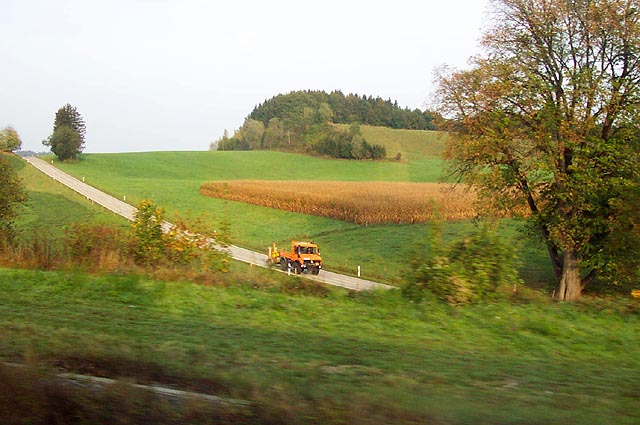
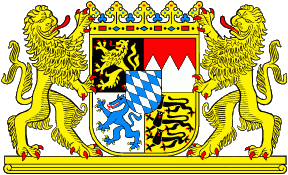
We got up early (5:30 AM) and had the breakfast buffet in the hotel restaurant. We then took a taxi to the Hauptbahnhof train station and caught the 7:49 AM train to Salzburg, Austria. After leaving the busy Munich area we quickly got into beautiful countrysides. We saw a lot of cornfields, as you can see in this photo. Note too the Mercedes-Benz orange Unimog!

The German trains are all electric and hence are very quiet. They are also very smooth. The German railroads (DB) have used the same width track as the US does (4' 8 1/2" or 1435 mm) since 1930.
We arrived in Salzburg at 9:25 AM. We began our walk from the train station to the center of town, but I was turned around so we were actually walking north rather than south into town.
We noticed from the start that the people definitely had a different look to them than the Bavarians of Munich. They looked more like Russians, definitely more eastern European. They did not smile. Ever. Beth tried making eye contract with many of them and gave them smiles, but they would never smile back. The people of Munich always smiled.
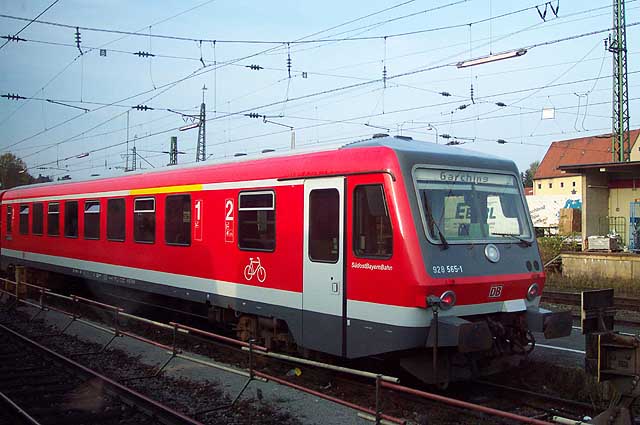
We turned around and soon found ourselves headed the right way. As we walked we saw this small Mercedes car, different from the joint-venture with Swatch. This car is called the A-Class, and boy are they slick!
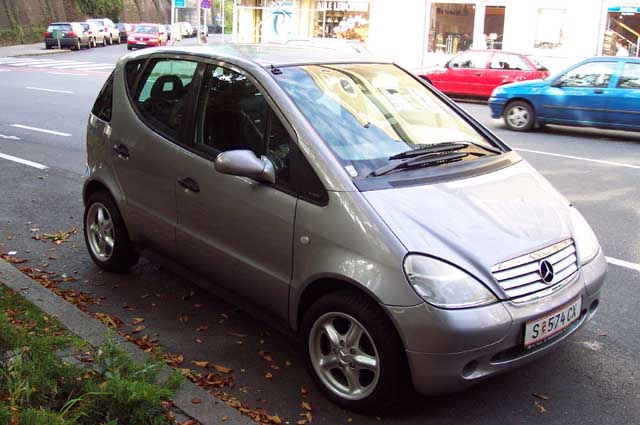
Soon we found ourselves in the middle of the Schranne Food Market in Mirabell Square, a weekly food market that happens each Thursday morning. There were many types of fresh fruit and vegetables for sale, along with booths selling prepared pastries and such. We got a drink and a snack. Notice the unusual pointy cabbages.
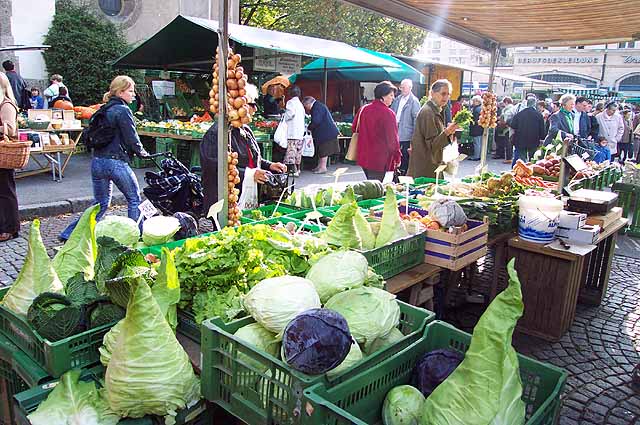
Just outside of a home that Mozart grew up in was this interesting Swatch Smart car being used as an advertisement for a Mexican restaurant! I never saw a tortilla in Germany.
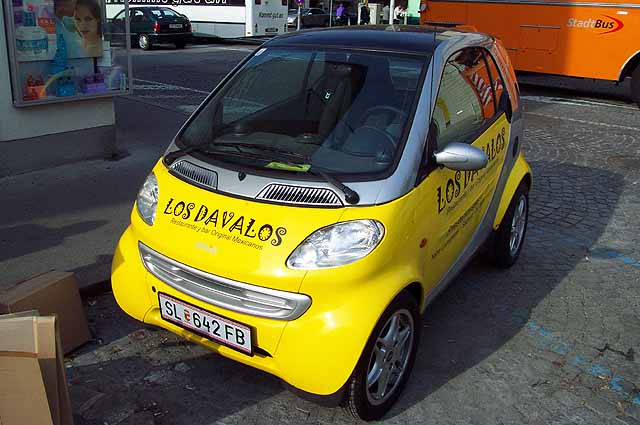
Salzburg is the home of Mozart. This fact is hard to ignore in the city as everything relates to Mozart. However, Salzburg is also the home to Christian Doppler, the scientist who discovered the Doppler principle used in radar. Here is where Mr. Doppler was born.

The yellow building in the back is where Wolfgang Amadeus Mozart was born in 1756. Mozart was just one of seven children born here to his father Leopold and his mother Anna Maria Walburga.
Salzburg had many streets in the Mozart birthplace area which did not allow cars. These roads were the best part of Salzburg, filled with restaurants, shops, markets and bakeries. We spent several hours browsing in these streets. Okay, browsing and eating... ;-)

It appeared that they allow a few cars on these streets. Here is a beautiful Mercedes-Benz E-Class estate (station wagon), probably either owned by a shop owner or a delivery vehicle. Station wagons are extremely popular in Europe. Minivans are also quite popular. Sport-utilities are very rare, and pickups as we know them are non-existent.
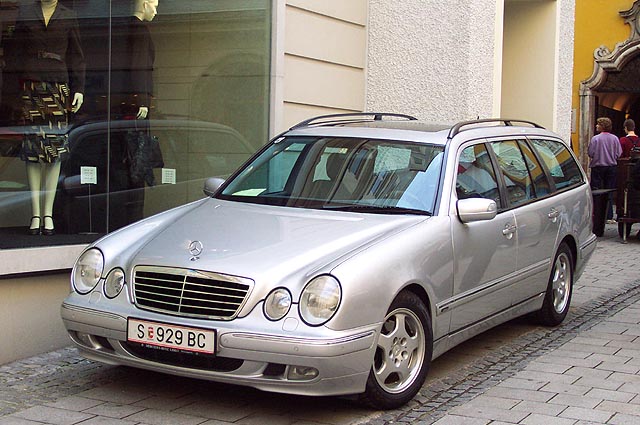
Here is the interior of one of the markets, where we stopped to buy some fruit and drinks. Notice the bananas hanging to the right. When you buy fruit or vegetables you weigh the fruit yourself and enter a code number for the type of fruit and then a sticker prints out that you put on the fruit. There are no scales at the registers. This way they only have to have one scale for the entire market: the one in the fruit and vegetable area, as opposed to the US style of having a scale at every register. This is an example of how Europe is more efficient in their use of resources than the US.
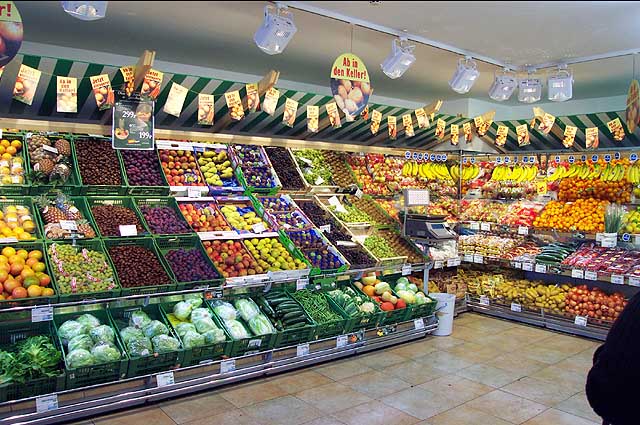
As we approached Cathedral Square on one of the neat shopping roads, we saw one of the special Salzburg tourist taxies: a horse and carriage. The Cathedral Arches can be seen here, built by Giovanni Antonio Dario from 1658 to 1663. The Square has a large statue of the Virgin built in 1771.
Note the sign on the right: Peterskeller. It is an excellent restaurant, one of the oldest in all of Austria. Unfortunately we did not eat there, so we'll have to go back!
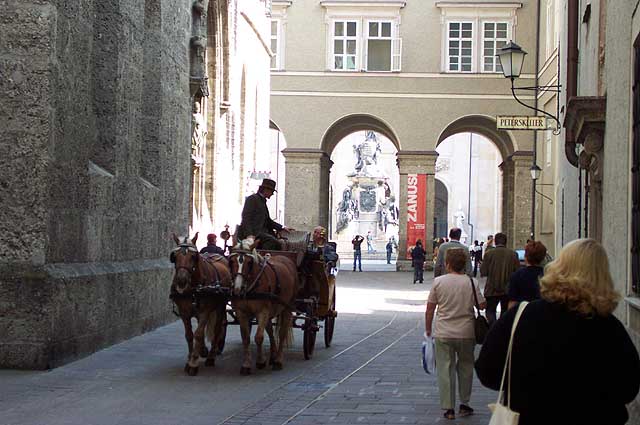
Cathedral Square has the main Cathedral of Salzburg. Originally built in 746 by an Irish abbot and bishop, the Cathedral was rebuilt by Archbishop Cardinal Konrad III von Wittelsbach from 1177 to 1183. A fire on December 11th, 1598 destroyed that building and a new building penned by Santino Solari was built from 1614 to 1628. On October 16th, 1944, the US Air Force bombed the Cathedral. The huge dome collapsed. It was not until 1959 that it was restored and the Cathedral reopened.
These buildings are perpetually being worked on. In 1987-1988 the old organ was replaced with four new pipe organs by the Swiss company Metzler. These organs are at the four corners of the crossing of the nave and all four are visible in this photo.
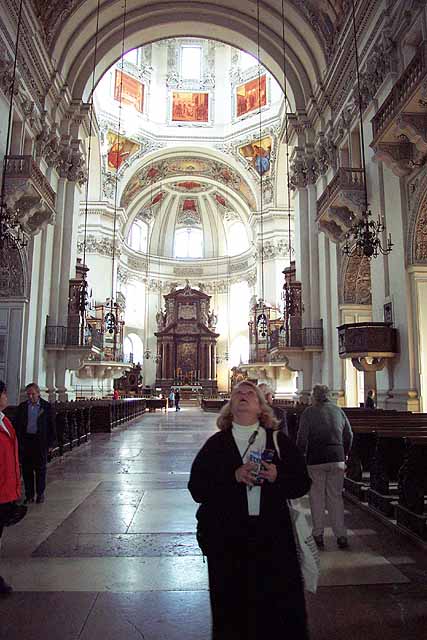
The intricacies of the three-dimensional sculptures in the ceiling were amazing.

Outside the cathedral was a dance troupe from the Ukraine which played folk music that seemed quite like Irish folk music to me. They were playing an instrumental here; later the back row came forward to dance, and one of the women sang a solo. They were selling their CD as well as taking donations.
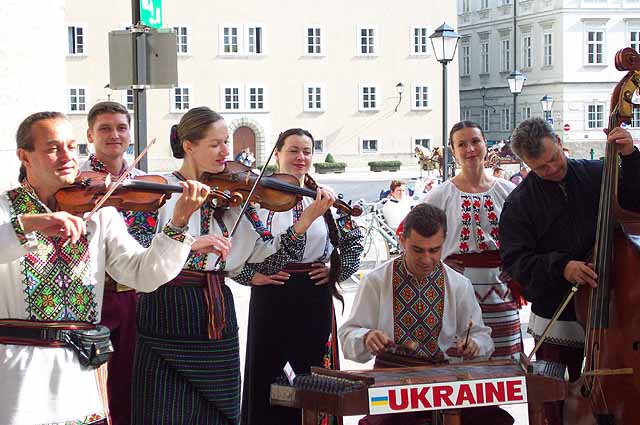
We next took a train up the hillside to a large fortress for which Salzburg is named. The train is called a Funicular, and it has been running since 1892. Electric motors power the train now, but it used to be water powered. It feels more like riding a gondola than a train.
At the top you arrive at the Hohensalzburg Fortress. The view from the top was wonderful. The large church in the foreground with a greenish dome is the main Salzburg Cathedral, the one the Air Force bombed.
Salzburg has a population of about 145,000 people. The Salzach river flows through the town, separating it into northern and southern parts. Salzburg is just barely over the border from Germany, as just north of Salzburg the Salzach river is the dividing line between the two countries.
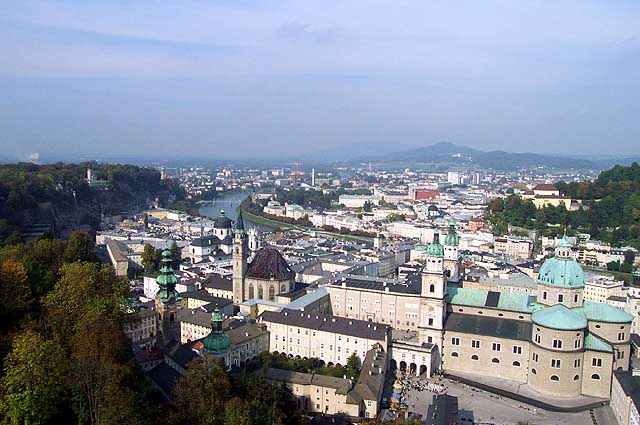
After our visit up to the fortress we began our walk back across the river to the north side of Salzburg and we rested at the beautiful Mirabell Palace gardens. From here we looked back south where you can see the Hohensalzburg fortress up on the hill.
Mirabell Palace was built in 1606, but burned down in 1818. The palace is now used as a seat of government. The gardens have lasted better than the palace, with the statues made in 1661 and 1690.

Here is a close-up of Hohensalzburg. It is considered as one of the best preserved Medieval fortresses in Europe. It certainly is the best that I've seen!
The fortress began being built in 1077 by Archbishop Gebhard I von Helffenstein as a place to take refuge from the German King Henry IV. (Gebhard had sided with the pope and the pope lost to the king, hence the fortress.) Numerous others in the following years enlarged and strengthened the fortress.
One interesting story has the archbishop and his attendants in the fortress, with dwindling provisions: a single bull is left to eat. The peasants below stormed the fortress, but each day the single bull is whitewashed and painted different colors and paraded in full view of the peasants. They figure that the archbishop's provisions are vast and give up. To do this day residents of Salzburg are therefore called bull washers.

On the way back on the train we met a Doctor about my own age who pulled out a graphite iBook on the train. I struck up a conversation with him. He deals with imagined hearing problems from both a medical and psychiatry point of view. His father was born in Munich in 1912 and lived through World War I and II. At the end of WW2 his father bought bombed out apartment buildings and fixed them up. The family now has a nice income from these properties 50 years later.
He explained how at the end of the war everyone became equal. Banks and money were wiped out and everyone was given 1000 DM, a new currency made for a new economy. The Russians took all of the machines and heavy equipment from Germany. At first the people were very upset by this, but within a short time they realized that this was a blessing in disguise, as Germany got all new machinery, the latest and greatest. Meanwhile the Russians were stuck with the German's old equipment! Thus Germany, especially West Germany, was given the kind of boost that got them started as a major Western producer of cars and other precision equipment.
At this point I was comfortable enough with this man to ask him a hard question that I had hoped to be able to ask a German, but wasn't hopeful of being able to do. I asked the man what Germans think of Hitler today. He said that many people wish to forget about Hitler and most do not talk about him. Hitler's book Mein Kampf is not allowed to be sold in Germany, although it is on the Internet as the Doctor acknowledged. He said that the Germans are a largely obedient people and that when Hitler came along as a leader, "the next thing you know we're all doing this" — and the Doctor does the "Hiel Hitler" salute a few times on the train! I was amazed that he would demonstrate it for me.
We continued to talk of computers, medicine, his family, and other things. We had a very enjoyable visit with this good man. As we neared Munich we asked him for a restaurant recommendation in the downtown Munich area, and he told us of a place that is not in the travel guides, but which has as good of Bavarian food as any place in the city, and for a reasonable price. He told us to go to the basement of the Bayerischer Hof, a famous old hotel, to a restaurant called the Palais Keller (cellar). We then said goodbye to our new friend.
Upon arriving back at the main train station we set out for the Bayerischer Hof. We got lost again but finally found it. It was a neat place and we had a great meal there. Here was the bill:
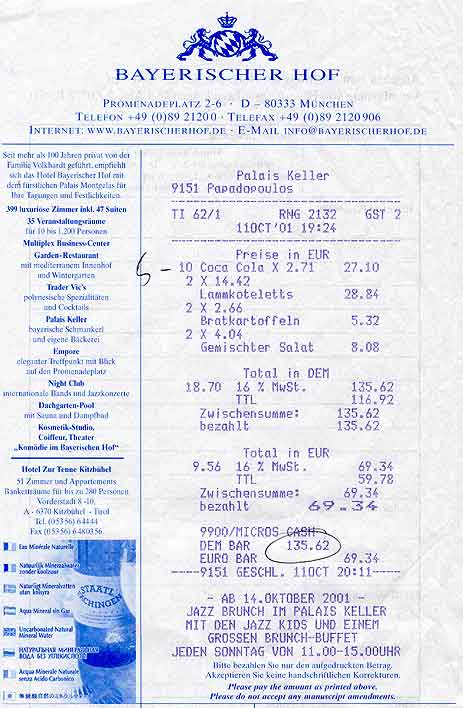
I call your attention to the fact that the Coca-Colas cost just about as much as our entrees! This is because Cokes are very expensive and quite small in size. They actually only brought us 5 Cokes, but they charged us for 10 because they were the large size. I had 3 Cokes, and Beth had 2.
I had no idea that they would cost this much, and none of them had any ice in them! Because we had been lost we had been walking a long time before we found the restaurant, so I was very, very thirsty. The total for dinner was about $63. Another first time tourist mistake!
We both had Lammkoteletts (lamb chops), which were extremely tasty, along with Gemischter Salat (mixed salad) und Bratkartoffeln (roasted potatoes), which were fabulous. It was worth it.
On to day 5, our 2nd day in Munich
Back to day 3, our 1st day in Munich
Back to Germany overview
Back to Dan Allen's Home Page
Created: 18 Oct 2001 Modified: 18 Oct 2001